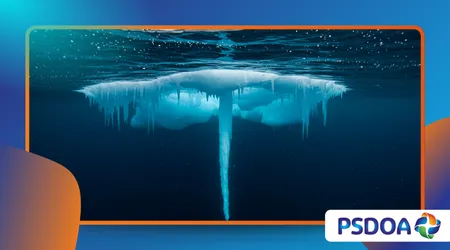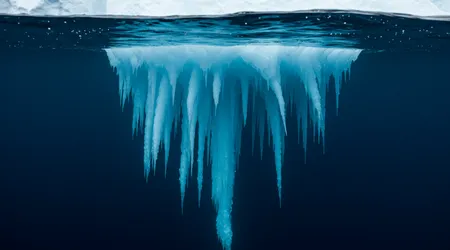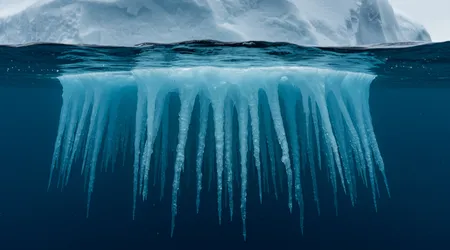Brinicles: The Deadly Underwater Icicles Forming Beneath Ice Shelves

Brinicles, eerie formations dubbed “icicles of death,” captivate scientists and nature enthusiasts alike, emerging beneath polar ice shelves with haunting beauty.
Anúncios
These rare natural phenomena, found in the frigid waters of the Arctic and Antarctic, are not just visually stunning but also a testament to nature’s complex interplay of chemistry and physics.
Unlike typical icicles, brinicles form underwater, where supercooled brine sinks, freezing surrounding seawater into delicate, tubular structures.
Their ethereal appearance belies a deadly impact on marine life, making them a subject of fascination and study in 2025.
This article dives into the science, ecological significance, and mysteries of brinicles, offering a fresh perspective on their role in polar ecosystems and their broader implications for our understanding of Earth’s dynamic environments.
Anúncios
Why do brinicles matter? They reveal the hidden forces shaping polar oceans, offering clues about climate change and marine resilience.
As we explore their formation, impact, and ongoing research, we’ll uncover why these icy tendrils are more than just a natural curiosity they’re a window into Earth’s delicate balance.
The Science Behind Brinicle Formation
Beneath polar ice shelves, brinicles begin as concentrated brine channels within sea ice, a process driven by temperature and salinity gradients.
When seawater freezes, it expels salt, forming dense, supercooled brine that sinks rapidly. This brine, colder than the surrounding water, freezes seawater it contacts, creating a tubular brinicle.
According to a 2011 BBC study, brinicles can form in hours, reaching lengths of several meters. Their formation hinges on precise conditions: calm waters and temperatures below -1.9°C.
This process resembles a chemical cascade, where brine acts like a sculptor, carving icy pathways downward.
Imagine a river of frost flowing through the ocean, solidifying everything in its path an apt analogy for brinicles’ mesmerizing growth. Yet, these conditions are rare, making their occurrence a fleeting spectacle in polar seas.
++Northern Lights: How and Where to Witness This Natural Spectacle
The physics of brinicles involves heat exchange and density differences. As brine sinks, it creates a feedback loop, drawing in more seawater to freeze.
This dynamic process, observed in McMurdo Sound, Antarctica, highlights nature’s ability to craft intricate structures from simple elements.
Brinicles are a reminder of the ocean’s hidden choreography, where temperature and salinity dance in delicate balance.

Ecological Impact of Brinicles
The beauty of brinicles masks their lethal impact on marine life, as they freeze organisms in their path, creating underwater “graveyards.” Starfish, sea urchins, and other slow-moving creatures are often encased in ice, unable to escape the encroaching frost.
A 2013 study in Antarctic Science documented brinicles affecting benthic communities, with up to 80% mortality in affected areas. This statistic underscores their role as natural disruptors in fragile ecosystems.
Consider a starfish, grazing peacefully on the seafloor, suddenly immobilized by a brinicle’s icy grip an example of nature’s harsh unpredictability.
These formations alter habitats, forcing species to adapt or perish. Yet, some microbes thrive in the briny microenvironments, showcasing life’s resilience.
Also read: Fire Rainbows: What Are They and Why Are They So Rare?
Brinicles also influence nutrient cycles by redistributing salt and organic matter. Their transient nature means ecosystems recover, but repeated events could stress populations.
In 2025, researchers are studying how climate-driven ice loss affects brinicle frequency, raising questions about long-term ecological shifts.
Brinicles and Climate Change
As polar ice shelves thin due to global warming, brinicle formation faces an uncertain future, with implications for ocean dynamics.
Thinner ice may reduce brine channels, potentially decreasing brinicle occurrences. Conversely, changing ocean currents could create new formation sites.
Scientists at the British Antarctic Survey note that brinicles serve as indicators of ice shelf stability, offering real-time insights into climate impacts.
Picture a polar bear on a shrinking ice floe, its world melting away brinicles face a similar existential threat. Their decline could signal broader disruptions in polar ecosystems.
Read more: Bioluminescent Waves: Beaches That Glow at Night
Ongoing research in 2025 explores how warming waters alter brine dynamics, affecting brinicle formation.
Rising sea temperatures also disrupt the delicate balance required for brinicles to form. War reduced ice cover, these phenomena may become rarer, limiting our ability to study them.
This loss would obscure our understanding of polar processes, making brinicles a poignant reminder of climate urgency.
Observing Brinicles in Real-Time
Studying brinicles is challenging due to their remote locations and unpredictable formation, but technology is changing that in 2025. Underwater drones and time-lapse cameras capture brinicles in action, revealing their growth patterns.
For instance, a National Geographic expedition in 2024 used submersibles to film brinicles in the Weddell Sea, providing unprecedented footage.
Imagine a diver, equipped with a thermal camera, watching a brinicle form in real-time a breathtaking blend of science and adventure.
These tools allow researchers to monitor temperature and salinity gradients precisely. Such observations are critical for understanding brinicle dynamics.
Data from these expeditions inform predictive models, helping scientists anticipate brinicle occurrences. The table below summarizes key environmental factors influencing brinicle formation, based on 2024 research:
| Factor | Requirement | Impact |
|---|---|---|
| Water Temperature | Below -1.9°C | Enables supercooling of brine |
| Salinity | High brine concentration | Drives sinking and freezing |
| Ocean Current | Minimal turbulence | Allows stable tube formation |
| Ice Thickness | Sufficient for brine channels | Supports brine expulsion |
This data highlights the delicate balance required for brinicles to form, emphasizing their sensitivity to environmental changes.
Brinicles as a Symbol of Nature’s Duality
Brinicles embody nature’s paradox: stunning beauty paired with destructive power, a reminder of Earth’s complex systems.
Their icy tendrils, illuminated by bioluminescent plankton, create a surreal underwater spectacle. Yet, their ability to freeze entire communities underscores nature’s indifference.
In 2025, brinicles are more than phenomena they’re metaphors for resilience and fragility.
What if brinicles could teach us to balance awe with responsibility? Their fleeting existence urges us to protect polar environments.
By studying brinicles, we gain insights into nature’s creativity and vulnerability, urging action against climate change.
Artists and scientists alike draw inspiration from brinicles, using their imagery to highlight environmental issues.
A 2025 art installation in Oslo featured brinicle-inspired sculptures, blending science and activism. These formations remind us that beauty and danger coexist, urging us to preserve Earth’s wonders.

Conclusion
Brinicles, with their ghostly elegance, are more than just icy curiosities they’re a lens into Earth’s polar mysteries and a call to action.
Their formation, driven by intricate physics, reveals nature’s ingenuity, while their ecological impact underscores its power.
As climate change threatens their existence, brinicles become symbols of urgency, urging us to protect fragile ecosystems.
In 2025, advancements in underwater technology offer hope for deeper understanding, but only if we act swiftly to preserve their icy habitats.
From starfish frozen in time to drones capturing their dance, brinicles blend science, art, and environmentalism.
They challenge us to marvel at nature’s creations while confronting our role in their survival. Will we heed their silent warning? By studying and protecting brinicles, we safeguard not just a phenomenon but the delicate balance of our planet’s future.
Frequently Asked Questions
What are brinicles, and why are they called “icicles of death”?
Brinicles are underwater icicles formed by sinking brine, freezing marine life in their path, earning the moniker for their deadly impact.
How do brinicles affect marine ecosystems?
They encase slow-moving organisms, like starfish, disrupting benthic communities, though some microbes adapt, showing nature’s complex balance.
Are brinicles becoming rarer due to climate change?
Thinning ice shelves may reduce brinicle formation, as warmer waters disrupt the necessary conditions, signaling broader polar ecosystem changes.
Can technology help study brinicles?
Yes, underwater drones and cameras capture brinicle formation in real-time, providing data on their growth and environmental triggers in 2025.
